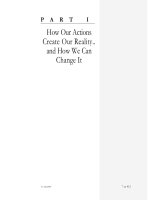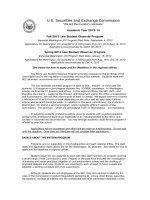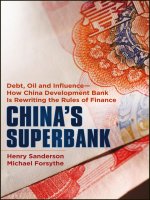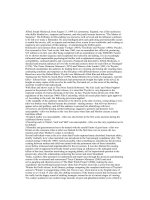fisher - crashes, crises, and calamities; how we can use science to read the early-warning signs (2011)
Bạn đang xem bản rút gọn của tài liệu. Xem và tải ngay bản đầy đủ của tài liệu tại đây (3.36 MB, 258 trang )
CRASHES, CRISES, AND
CALAMITIES
Also by LEN FISHER
The Perfect Swarm:
The Science of Complexity in Everyday Life
Rock, Paper, Scissors:
Game Theory in Everyday Life
Weighing the Soul:
Scientific Discovery from the Brilliant to the Bizarre
How to Dunk a Doughnut:
The Science of Everyday Life
2
CRASHES, CRISES, AND
CALAMITIES
HOW WE CAN USE SCIENCE TO
READ THE EARLY-WARNING SIGNS
Len Fisher
A Member of the Perseus Books Group
New York
Copyright © 2011 by Len Fisher
Published by Basic Books,
A Member of the Perseus Books Group
All rights reserved. Printed in the United States of America. No part of
this book may be reproduced in any manner whatsoever without written
permission except in the case of brief quotations embodied in critical
articles and reviews. For information, address Basic Books, 387 Park
Avenue South, New York, NY 10016-8810.
Books published by Basic Books are available at special discounts for
bulk purchases in the United States by corporations, institutions, and
other organizations. For more information, please contact the Special
Markets Department at the Perseus Books Group, 2300 Chestnut Street,
Suite 200, Philadelphia, PA 19103, or call (800) 810-4145, ext. 5000,
or e-mail
Text set in 10.5 point Weidemann Book
Library of Congress Cataloging-in-Publication Data
Fisher, Len.
Crashes, crises, and calamaties : how we can use science to read
the early-warning signs / Len Fisher.
p. cm.
ISBN: 978-0-465-02102-4 (hardback)
1. Accidents—Prevention. 2. Natural disasters—Forecasting.
3. Science—History. 4. Science—Social aspects. 5. Scientists.
I. Title.
HV675.F49 2011
363.34'63—dc22
2010048289
E-book ISBN: 978-0-465-02335-6
10 9 8 7 6 5 4 3 2 1
To Wendella, who has survived
yet another book without crashes,
crises, or calamities.
Acknowledgments ix
A User’s Guide to This Book xi
Introduction: How Do Toads Predict Earthquakes? xiii
PART 1: A POTTED PRE-HISTORY OF PROGNOSTICATION
1 Do Animals Have Crystal Balls? 3
2 The Future Eclipsed 15
3 Galileo’s Hell 25
PART 2: HOW DISASTERS HAPPEN
4 The Stress of It All 35
5 Runaway Disaster 53
6 The Balance of Nature and the Nature of Balance 71
PART 3: IMMINENT CATASTROPHES: READING THE SIGNS
7 The Chaotic Ecology of Dragons 95
8 Teetering on the Brink of Catastrophe 109
9 Models and Supermodels 123
10 Beware of Mathematicians 135
11 Weak Signals as Major Early-Warning Signs 151
Summary: The Future of Forecasting 169
Notes 171
Index 219
vii
CONTENTS
ACKNOWLEDGMENTS
My background and contacts in science have given me privileged access
to the specialists who are contributing to the rapid development of fore-
casting methods. Many of them have been kind enough to offer percep-
tive criticisms, suggestions, corrections, and information in areas where
I am not a specialist. Other friends and colleagues have read the man-
uscript from the nonspecialist’s point of view, and their suggestions have
contributed considerably to its clarity. I must especially thank my wife,
Wendella, who has carefully gone through every page on behalf of the
eventual reader, and my agent Barbara Levy for her constant support
and belief in what I am trying to do to help integrate science into our
wider culture.
Without the help of all these people, this book would not have been
possible in its present form. In alphabetical order, those who have made
helpful suggestions or provided valuable information are:
Michael Adam, Scott Arthur, Nicola Beech, William Brock, Trish
Brown, Steve Carpenter, David Dacam, Underwood Dudley, David Fisher,
Wendella Fisher, Eric Foner, Gerd Gigerenzer, Garry Graham, Stephen
Guastello, Paul Halpern, Dirk Helbing, Wilhelm Krücken, Alan Lane,
Leon Lederman, Matthys Levy, John Lienhard, Rosalinda Madara, Spyros
Makridakis, Richard C. Malley, Robert May, Heather Mewton, Marion
Mittermaier, Jeff Odell, Roger Pearse, Mark Peterson, Andrew Pyle, Guy
Raffa, Mike Retzer, Paul Rosch, Harry Rothman, Marten Scheffer, Alistair
Sharp, Ian Stewart, Noel Swerdlow, Graham Turner, Phil Vardy, Charlie
Warwick, and Beth Wohlgemuth.
ix
If I have omitted anyone, I hope that they will forgive the uninten-
tional oversight, which I am very happy to correct on my website and
in any future editions.
With more than the usual nod toward “any mistakes that remain
are my own,” I must acknowledge that, despite the help of all these
kind people, it is quite possible that, in my efforts to understand, simplify,
and make sense of complex material, I may on occasion have been
drawn into error. I would be more than pleased to have errors and mis-
understandings pointed out in what I hope will be an ongoing dialogue
on my website (www.lenfisherscience.com) and elsewhere.
Acknowledgments
x
A USER’S GUIDE TO THIS BOOK
This book is designed to be dipped into. While the chapters are presented
in chronological order of discovery, they can be read in virtually any
order, depending on the reader’s interests. My aim is to provide solid
information about how we can detect and use early-warning signs to
anticipate personal and global disasters. Almost any chapter will have
relevant, interesting and often unexpected information for readers to
digest and use.
If you want the latest news on global warming, for example, you
might like to start with Chapter 9, which tells the story of how models
have been developed to help us predict future events in complex per-
sonal and global scenarios. If you want an up-to-date list of early-warning
signs relevant to our daily lives, you might even turn straight to Chapter
11, which gives such a list, beginning with the little-known fact that
the height of women’s hemlines is a remarkably accurate warning sign
of changing economic circumstances.
The task of unearthing this information, putting it into familiar con-
texts, and applying it to problems that affect us all has been endlessly
fascinating. I hope that you enjoy sharing my journey of discovery.
xi
INTRODUCTION: HOW DO
TOADS PREDICT EARTHQUAKES?
The clever men at Oxford
Know all that there is to be knowed.
But they none of them know one half as much
As intelligent Mr. Toad!
—Kenneth Grahame, The Wind in the Willows (1908)
On April 1, 2009, the toads in San Ruffino Lake in central Italy left their
traditional breeding grounds and headed for the hills. Five days later, a
violent earthquake hit the region, demolishing the nearby medieval
town of L’Aquila and killing more than three hundred people.
By a singular act of serendipity, the British ecologist Rachel Grant
happened to be studying the mating behavior of the toads at the time
of the earthquake. She was understandably annoyed when the toads
suddenly disappeared from her study site, but thrilled when they re-
turned the day after the earthquake—not just because she could con-
tinue her study, but because she was the first scientist to be able to
confirm the many anecdotal reports over the centuries of animals acting
strangely just before a natural disaster.
Following her scientific account of the phenomenon, there have
been suggestions that we could use the behavior of toads or other an-
imals as early-warning signs for earthquakes. Whether this suggestion
will withstand scrutiny is not clear, but at least we may be able to dis-
cover any physical signals that the animals are responding to and mon-
itor those.
xiii
xiv
Introduction
What is clear is that the detection of early-warning signals can make
a huge difference to our ability to deal with upcoming crashes, crises, and
calamities—not only in the natural world but also in our personal lives
and in our social and economic environments. This is especially true for
the sorts of events that scientists have labeled as critical transitions.
In these events, things have been going along smoothly, or changing
at a comfortable, steady pace, until abruptly, without apparent warning,
there is a jump to a very different state. A volcano explodes; a market
collapses; a bridge falls down; a relationship blows up; an epidemic takes
off; war breaks out. All of these events, in the scientists’ terminology,
are critical transitions.
In this book I tell the story of mankind’s search for warning signs
of such events, and how it has culminated with the recent discovery of
a set of early-warning signs that are common to critical transitions of all
kinds. I show how these exciting discoveries could be of inestimable
value in helping us to predict and deal with sudden crashes, crises, and
calamities, both in our personal lives and in the world around us.
Mankind has sought warning signs of such events for millennia.
Some cultures put their trust in seers and oracles who were believed to
be able to “see” the future. Others looked for omens and harbingers of
disaster in the form of unusual heavenly events such as eclipses—a belief
that strongly resonates with the modern-day belief in the power of eco-
nomic and social forecasters, who search for unusual social and economic
indicators to guide their prophecies.
With the coming of the scientific era, physical laws began to be un-
covered that could act as valuable aids to prediction. Galileo was the
first off the blocks when he used simple physical principles to calculate
how thick the roof of hell would have to be so that it did not collapse in
on itself. Later scientists built on Galileo’s physical ideas to develop the
concept of stress, which engineers use to help predict whether structures
* This definition of feedback in the physical sense is different from how psychologists define
the term; it is the latter usage that has found its way into everyday speech. I clarify the difference
in Chapters 4 to 6.
xv
Introduction
like bridges and buildings will be able to support their own weight. This
was a considerable advance on the medieval approach of trial and
error: a great many cathedrals collapsed during construction or under
the influence of the first high wind because the concept of stress was
not fully understood.
The physical concept of stress has been “borrowed” by psychologists
as an aid to understanding our response to different circumstances. They
use it as a measure of the effect that difficult circumstances can have
on us, and whether we can cope, or whether we might collapse like the
medieval cathedrals.
Stress is not the only conceptual tool that psychologists have bor-
rowed from the physical sciences. An equally important one is feedback,
which forms the core of our present understanding about how critical
transitions arise.
Feedback comes in two forms—positive and negative. Positive feed-
back reinforces change; negative feedback damps change down and re-
stores equilibrium. Positive feedback can lead to runaway collapse.
Negative feedback maintains the balance.
*
Positive feedback works by reinforcing change, with the strength
of the reinforcement increasing as the change increases. This means
that the rate of change continuously accelerates—an apparently insignifi-
cant initial change can grow to become a catastrophically big one. A
ladder that starts to tilt and fall while you are at the top, growing panic
in a crowd, a run on a bank, the growth of an avalanche from tiny be-
ginnings, the evolution of an arms race, the runaway collapse of a frag-
ile ecosystem, the increasing violence of arguments in a deteriorating
relationship—these are all examples of positive feedback.
xvi
Introduction
Negative feedback works by providing a restoring force that becomes
stronger when change threatens to become larger—like the governor
on an engine, which gradually closes off the fuel supply as the engine
speeds up, or the way we steer a car by turning the wheel to correct
any deviations from the line that we want the car to take. Our bodies
also use negative feedback in many ways to maintain homeostasis. The
hotter we get, for example, the more we perspire, and the greater be-
comes the cooling effect as the perspiration evaporates.
On a larger scale, it has been proposed that the “balance of nature”
and the “invisible hand” of free market competition provide long-term
stability by introducing negative feedback into ecosystems and
economies, respectively. Unfortunately, it’s a myth in both cases. Such
negative feedback processes can provide temporary stability, but in the
long term our ecosystems and our economies, like our bodies, our re-
lationships, and our societies, are all governed by a complex and con-
stantly shifting balance of positive and negative feedback processes.
Critical transitions happen when positive feedback or some other
“runaway” process (such as a buildup of stress) takes over from the nor-
mal balancing processes of negative feedback. Our problem in predicting
personal, social, economic, and natural disasters is learning how to tell
when the balance is stable, on the one hand, and when we are getting
dangerously close to a point of instability, on the other. When we get to
such a point, intolerable stresses may provoke a sudden collapse, and
runaway processes such as positive feedback may suddenly take over
and cause the system to run out of control and fail catastrophically.
The underlying processes that produce critical transitions have a lot
in common, but until recently the task of predicting the imminence of
a critical transition has seemed close to impossible. Sometimes it is gen-
uinely impossible, but in the last decade new insights and the develop-
ment of increasingly powerful computers have allowed scientists to look
* The first two were Rock, Paper, Scissors: Game Theory in Everyday Life (New York: Basic
Books, 2008) and The Perfect Swarm: The Science of Complexity in Everyday Life (New York:
Basic Books, 2009).
xvii
Introduction
more deeply into the question. What they have seen offers fresh hope.
Out of a dizzying mess of action and reaction, deviation and correction,
process and counterprocess, there has come into focus a remarkable set
of universal early-warning signs that tell us when situations are about to
become critical and when runaway processes are about to take over.
The signs are similar no matter whether we are talking about social
disruption, economic disaster, ecosystem collapse, or climate change
and other natural catastrophes. Most of the signs are also simple—simple
enough for all of us to understand and take heed of.
Such early-warning signs promise to let us do Monday morning
quarterbacking on a Saturday morning by using discoveries from physics,
mathematics, and the world of nature to forecast and handle sudden
shocks, surprises, and catastrophes, whether in our personal lives or in
the world around us.
When I first came across these findings and recognized their pro-
found importance, I realized that this was something we should all know
about. I couldn’t wait to find out more and to share my discovery.
This book is the result. It tells the story of mankind’s search for pre-
dictors of disaster and investigates how we might use the recent and
still-evolving discovery of a new set of generic early-warning signs to
take firmer control of our own future and the future of the planet.
A NOTE TO READERS
This is the third book in a trilogy in which I investigate how we can use
results from the so-called hard sciences to understand and alleviate the
personal and social problems that we face in today’s complex society.
*
xviii
Introduction
It is a detective story rather than a sermon—a shared journey of dis-
covery into a new and exciting area of science that is helping us under-
stand more fully the sources of some of our most pressing personal and
global problems.
My main aim has been to provide stimulating and thought-provoking
ideas from areas that may not be familiar to all readers. I have had to
prune and simplify in order to clarify; almost every paragraph could have
been expanded into a whole chapter, or even a book. In compensation,
there are extensive notes for those who want to pursue particular
issues in depth. The notes are an eclectic collection of fascinating an-
ecdotes, references, and additional background information that I came
across during my research but couldn’t easily work into the main text.
They provide an additional dimension and are a detailed resource for
those who would like to take up any of the issues I address. Some readers
of previous books of mine have even written to say that the set of notes
is where they start reading!
Each note is linked to a particular point in the main text, but the
notes as a whole are designed to be read independently and also to direct
the reader to the most interesting and important original references. I
have taken some pains to select the most readable references for the
nonspecialist and to add comments when needed. Whether you start
with the notes or the main text, I hope that this book stimulates you to
think in new and creative ways about your own and the world’s future.
Len Fisher
Bradford-on-Avon, United Kingdom,
and Blackheath, Australia
a b
g
h f F
PART 1
A POTTED PRE-HISTORY
OF PROGNOSTICATION
1
Do Animals Have Crystal Balls?
For animals, the entire universe has been neatly divided into
things to (a) mate with, (b) eat, (c) run away from, and (d) rocks.
—Terry Pratchett, Equal Rites (1987)
In 373 BC, the Greek city of Helike, situated on the shore of the Pelo-
ponnesus peninsula, was hit by a huge earthquake and then drowned
by the ensuing tsunami. Five hundred years later, the ruins could still
be seen beneath the clear green waters of the Gulf of Corinth. Roman
tourists would sail above them to admire the sunken walls and statuary,
and the story of Atlantis may have been based on these ruins.
Then Helike disappeared. The site silted over, nothing could be seen
of its buildings and statues, and memory of its whereabouts was lost.
The city was not rediscovered until 2001, when it was found buried in
an ancient lagoon. It is now a marine archaeological site—one of the
most endangered in the world.
Memory of the city’s location may have been lost, but the circum-
stances of its passing were recorded by several historians, among them
the Roman author Claudius Aelinius (Aelian). His account is particularly
important because it contains the first description of animals “predicting”
an earthquake. According to Aelian:
For five days before Helike disappeared, all the mice and martens and
snakes and centipedes and beetles and every other creature of that kind
in the city left in a body by the road that leads to Keryneia [Corinth].
3
And the people of Helike seeing this happening were filled with amaze-
ment, but were unable to guess the reason. But after these creatures had
departed, an earthquake occurred in the night; the city subsided; an im-
mense wave flooded and Helike disappeared.
There have been many other reports of animals behaving oddly be-
fore a tsunami. There are apparently reliable anecdotal reports, for ex-
ample, of animals fleeing for safety before the disastrous Asian tsunami
of December 26, 2004, including stories told to me personally when I
was in the area a fortnight later. But what could produce such behavior?
Some people believe that animals have a “sixth sense” that enables them
to detect forthcoming danger. If this sensitivity to future events really
exists, and if it can be harnessed, then forecasting the onset of disasters
would suddenly become a whole lot easier.
One example of this sense is the claimed ability of some dogs to
“know” when their owners are coming home. One such claim was “in-
vestigated” by an Austrian television company, whose film appeared to
contain convincing proof that a dog called Jaytee could tell when its
owner was setting off to return home from a distant location and would
promptly go to the porch and wait. Parallel filming of the dog and the
owner appeared to confirm this claim in dramatic fashion.
When the psychologist Richard Wiseman and his colleagues inves-
tigated the claim, they found that there could have been many other
explanations. In the Austrian program, for example, the person filming
the dog’s behavior appears to have known of the planned return time
and may have given inadvertent signals to the dog. To eliminate this
and other possibilities, Wiseman and his colleagues set up a protocol of
having the return time selected randomly by an experimenter who ac-
companied the owner after they had left the house, and without inform-
ing an observer who had remained in the house to watch the dog’s
behavior. With this protocol in place, there was no evidence at all for
the original claim.
Crashes, Crises, and Calamities
4
There were even more flaws in the “experiments” involving Paul
the octopus during the 2010 World Cup of soccer. Housed in a German
aquarium, the animal correctly predicted the result of every match in-
volving the German team (usually a win), and also the result of the final,
simply by choosing food from one of two boxes labeled with the appro-
priate national flags.
The octopus’s performance provoked public enthusiasm and criticism
in equal measure, especially among the German public—enthusiasm
when the octopus predicted a German win (Germany was usually by
far the favored team) and outrage when it successfully predicted Ger-
many’s ultimate loss to Spain, with some fans calling for the octopus to
be cooked and eaten—a classic case of shooting the messenger. This re-
sponse was nothing, though, compared to that of Iranian president Mah-
moud Ahmadinejad, who accused the West of using the octopus to
spread “Western propaganda and superstition.”
But how did the octopus do it? Before we can possibly countenance
claims of psychic powers, we need to follow Wiseman’s example in the
case of the “psychic dog”—that is, we need to be quite sure that the
powers are real and that all reasonable alternative explanations have
been eliminated.
In Paul’s case, even the powers are in dispute, because he did not
do nearly so well in predicting the results of the earlier European Cup
(getting only four results correct out of six). There are also plenty of
alternative explanations for his later astonishing success. The boxes were
transparent, so he could see the flags, and he may have been more at-
tracted to the German flag. There were no precautions in place to ensure
that the keeper wasn’t giving clues about his own expectations. None
of the results was really unexpected, and Germany and Spain (to whom
Germany eventually lost) were the pre-tournament favorites. The piece
of octopus food (a mussel) may even have been made larger (not nec-
essarily deliberately) in the box that the keeper favored.
Do Animals Have Crystal Balls?
5
All in all, it was a bit of fun, but as a scientific experiment—forget
it. In fact, forget all of the so-called proofs that animals have psychic
powers. It is incredibly difficult to design a scientific experiment that
eliminates all other reasonable explanations and leaves psychic powers
as the only alternative.
That’s not to say that some animals may not have other special pow-
ers. The toads of San Ruffino Lake, for example, may have been sensitive
to the increase in very low-frequency radio emissions from the iono-
sphere that preceded the earthquake; indeed, some seismologists believe
that such emissions could act as early-warning signals for many earth-
quakes. The same seismologists have pointed out, however, that if we
could establish a genuine correlation between animal behavior and
some physical change, that would mean that we were already able to
measure the physical change and thus would have no need to rely on
the animal behavior to make our predictions.
COULD HUMAN “PRECOGNITION”
HELP US PREDICT THE FUTURE?
With humans, it’s different. We can test the possibility of precognition
more thoroughly because our ability to verbalize allows us to make more
detailed predictions than if we were limited to purely behavioral clues.
One of the first people to attempt such a test was the fabulously
wealthy King Croesus, who ruled the ancient kingdom of Lydia (in what
is now northern Turkey) from 560 to 546
BC. Croesus wanted to know
just how reliable were the predictions of the many “Oracles” then plying
their fortune-telling trade, and he decided to investigate their abilities
before paying hard cash for their advice. To perform his test, he sent mes-
sengers with instructions to ask each Oracle on a prearranged day “what
Croesus, son of Alyattes and king of Lydia, was doing at the moment.”
Crashes, Crises, and Calamities
6









